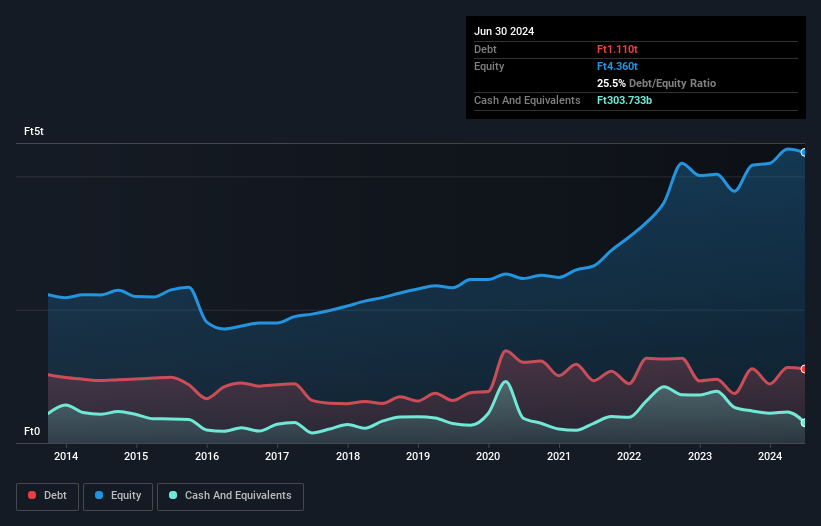- Hungary
- /
- Oil and Gas
- /
- BUSE:MOL
Is MOL Magyar Olaj- és Gázipari Nyilvánosan Muködo Részvénytársaság (BUSE:MOL) A Risky Investment?

Legendary fund manager Li Lu (who Charlie Munger backed) once said, 'The biggest investment risk is not the volatility of prices, but whether you will suffer a permanent loss of capital.' So it might be obvious that you need to consider debt, when you think about how risky any given stock is, because too much debt can sink a company. As with many other companies MOL Magyar Olaj- és Gázipari Nyilvánosan Muködo Részvénytársaság (BUSE:MOL) makes use of debt. But is this debt a concern to shareholders?
When Is Debt A Problem?
Debt is a tool to help businesses grow, but if a business is incapable of paying off its lenders, then it exists at their mercy. Part and parcel of capitalism is the process of 'creative destruction' where failed businesses are mercilessly liquidated by their bankers. However, a more frequent (but still costly) occurrence is where a company must issue shares at bargain-basement prices, permanently diluting shareholders, just to shore up its balance sheet. Of course, debt can be an important tool in businesses, particularly capital heavy businesses. The first step when considering a company's debt levels is to consider its cash and debt together.
View our latest analysis for MOL Magyar Olaj- és Gázipari Nyilvánosan Muködo Részvénytársaság
How Much Debt Does MOL Magyar Olaj- és Gázipari Nyilvánosan Muködo Részvénytársaság Carry?
The image below, which you can click on for greater detail, shows that at June 2024 MOL Magyar Olaj- és Gázipari Nyilvánosan Muködo Részvénytársaság had debt of Ft1.11t, up from Ft741.8b in one year. However, it does have Ft303.7b in cash offsetting this, leading to net debt of about Ft806.3b.

How Strong Is MOL Magyar Olaj- és Gázipari Nyilvánosan Muködo Részvénytársaság's Balance Sheet?
We can see from the most recent balance sheet that MOL Magyar Olaj- és Gázipari Nyilvánosan Muködo Részvénytársaság had liabilities of Ft1.79t falling due within a year, and liabilities of Ft1.81t due beyond that. Offsetting these obligations, it had cash of Ft303.7b as well as receivables valued at Ft1.13t due within 12 months. So it has liabilities totalling Ft2.16t more than its cash and near-term receivables, combined.
When you consider that this deficiency exceeds the company's Ft1.68t market capitalization, you might well be inclined to review the balance sheet intently. In the scenario where the company had to clean up its balance sheet quickly, it seems likely shareholders would suffer extensive dilution.
We use two main ratios to inform us about debt levels relative to earnings. The first is net debt divided by earnings before interest, tax, depreciation, and amortization (EBITDA), while the second is how many times its earnings before interest and tax (EBIT) covers its interest expense (or its interest cover, for short). This way, we consider both the absolute quantum of the debt, as well as the interest rates paid on it.
MOL Magyar Olaj- és Gázipari Nyilvánosan Muködo Részvénytársaság has net debt of just 0.66 times EBITDA, suggesting it could ramp leverage without breaking a sweat. And remarkably, despite having net debt, it actually received more in interest over the last twelve months than it had to pay. So there's no doubt this company can take on debt while staying cool as a cucumber. But the other side of the story is that MOL Magyar Olaj- és Gázipari Nyilvánosan Muködo Részvénytársaság saw its EBIT decline by 7.1% over the last year. If earnings continue to decline at that rate the company may have increasing difficulty managing its debt load. When analysing debt levels, the balance sheet is the obvious place to start. But it is future earnings, more than anything, that will determine MOL Magyar Olaj- és Gázipari Nyilvánosan Muködo Részvénytársaság's ability to maintain a healthy balance sheet going forward. So if you're focused on the future you can check out this free report showing analyst profit forecasts.
But our final consideration is also important, because a company cannot pay debt with paper profits; it needs cold hard cash. So we always check how much of that EBIT is translated into free cash flow. Looking at the most recent three years, MOL Magyar Olaj- és Gázipari Nyilvánosan Muködo Részvénytársaság recorded free cash flow of 42% of its EBIT, which is weaker than we'd expect. That's not great, when it comes to paying down debt.
Our View
We'd go so far as to say MOL Magyar Olaj- és Gázipari Nyilvánosan Muködo Részvénytársaság's level of total liabilities was disappointing. But at least it's pretty decent at covering its interest expense with its EBIT; that's encouraging. Once we consider all the factors above, together, it seems to us that MOL Magyar Olaj- és Gázipari Nyilvánosan Muködo Részvénytársaság's debt is making it a bit risky. Some people like that sort of risk, but we're mindful of the potential pitfalls, so we'd probably prefer it carry less debt. The balance sheet is clearly the area to focus on when you are analysing debt. But ultimately, every company can contain risks that exist outside of the balance sheet. These risks can be hard to spot. Every company has them, and we've spotted 2 warning signs for MOL Magyar Olaj- és Gázipari Nyilvánosan Muködo Részvénytársaság (of which 1 makes us a bit uncomfortable!) you should know about.
At the end of the day, it's often better to focus on companies that are free from net debt. You can access our special list of such companies (all with a track record of profit growth). It's free.
If you're looking to trade MOL Magyar Olaj- és Gázipari Nyilvánosan Muködo Részvénytársaság, open an account with the lowest-cost platform trusted by professionals, Interactive Brokers.
With clients in over 200 countries and territories, and access to 160 markets, IBKR lets you trade stocks, options, futures, forex, bonds and funds from a single integrated account.
Enjoy no hidden fees, no account minimums, and FX conversion rates as low as 0.03%, far better than what most brokers offer.
Sponsored ContentNew: Manage All Your Stock Portfolios in One Place
We've created the ultimate portfolio companion for stock investors, and it's free.
• Connect an unlimited number of Portfolios and see your total in one currency
• Be alerted to new Warning Signs or Risks via email or mobile
• Track the Fair Value of your stocks
Have feedback on this article? Concerned about the content? Get in touch with us directly. Alternatively, email editorial-team (at) simplywallst.com.
This article by Simply Wall St is general in nature. We provide commentary based on historical data and analyst forecasts only using an unbiased methodology and our articles are not intended to be financial advice. It does not constitute a recommendation to buy or sell any stock, and does not take account of your objectives, or your financial situation. We aim to bring you long-term focused analysis driven by fundamental data. Note that our analysis may not factor in the latest price-sensitive company announcements or qualitative material. Simply Wall St has no position in any stocks mentioned.
About BUSE:MOL
MOL Magyar Olaj- és Gázipari Nyilvánosan Muködo Részvénytársaság
Operates as an integrated oil and gas company in Hungary and internationally.
Flawless balance sheet established dividend payer.
Similar Companies
Market Insights
Community Narratives



